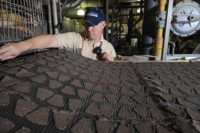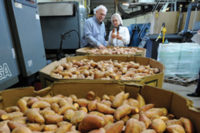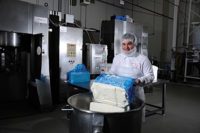When Kangaroo Brands, Inc., Milwaukee, expanded its product line to include the baked all-natural pita chips in a variety of flavors, consumers couldn’t get enough. It was quickly apparent that the company would have to expand its production capacity and add a second production plant for pita chips. The pita chips include eight basic stock-keeping units (SKUs) including six main Kangaroo Pita Chip varieties and two new Corn-Fusion Crisps chip products. Flavors in the main line comprise Sea Salt, Multi-Grain Sea Salt, Multi-Grain Garden Herb, Zesty Cheddar, Garlic Herb and Salt ‘n Pepper. Corn-Fusion Crisps come in Chili Lime and Sea Salt.
The explosive growth of the chips, which come in bags sized from 1.25 to 30 oz., prompted Kangaroo owner/brothers John and George Kashou, president/CEO and vice president, respectively, to find a separate facility, now at 74,000 square feet., a few miles away from their headquarters. Within the spanking clean facility is a 40,000-sq.-ft. warehouse and two internal flour silos that each hold 140,000 lbs. of flour that’s piped overhead to each of the production lines. The silos are kept within the plant to avoid harsh weather extremes, says Greg Gonzales, plant manager-chips.
The company’s 55,000-sq.-ft. headquarters location in Milwaukee, which handles all of the pita bread products, was expanded three times. While it seems ample enough, there’s no more room for another expansion. Demand for the pita chip snacks was outpacing everything else, so the second production plant was a must. “The pita chips really usurped everything else we make so far,” admits George.
Since the chip plant opened in 2007, Kangaroo continued to double its production capacity, and currently generates as much as 4,000 lbs. of chips per hour. A former bagel factory, the chip plant sits on five acres of land.
“When we moved to our first big plant in Milwaukee in 1986 as young entrepreneurs, we thought it was a huge place compared to the little bakery we first ran,” George remembers. “We quickly outgrew it, however. We wanted our second plant to be close by, and it gives us all sorts of expansion opportunities.”
Chipping in with new technology
At Kangaroo, the baked pita chips start with baking the right pita bread. As George says, “First, you have to make good pita bread. Then, you have to cut it, bake it, toast it and season it, so the first part of production is the very same exact thing we do at our other plant that makes pita bread,” he explains. “Some of that same equipment on the chip lines is used on our bread lines at the other plant for baking pita bread. The differences between the two are after the baking process where we cut, toast and season the chips.”
Achieving the perfect pita pocket technology was how the Kashous started their company, explains John Kashou, chief executive officer and owner. “We wanted to make a better pita with a better pocket that would open consistently and cleanly—that’s the whole premise in how we make a better pita. If it opens cleanly, consumers can gain access to it. Before we got into this business, most pocket breads in the industry had all kinds of flaws. The pita bread stuck together. So the technology and production systems we developed give us the ability to produce a consistent shape and a consistent pocket in the bread.”
John determined that conventional processing equipment just wasn’t geared to make what he considers really top-quality, consistent pita bread and a pocket bread that opens cleanly on a mass-produced basis. He also uses his own equipment designs to produce the pita chips for that matter. Made from the pita dough, the chips are sturdy and substantial. Measuring 1.25 by 2 in., they work very well for dipping into hummus or other dips, but also function as a crunchy snacking chip.
“Back in the early ‘80s, John started tinkering and engineering (he has an engineering background), and designed a seamless line that can extrude, sheet, cut, proof and bake a consistent product with the flavor and importantly the elasticity we were after,” says George. “We design and build most of our own equipment,” John says. “It’s one of our core strengths. This allows us to bake the products customers want and to build flexibility into our lines.”
John’s son Salem Kashou, marketing manager, cites the importance of why the pita products are so first-rate: “Our bread is unmatched because of the equipment my dad built and designed to produce it. You’re not going to find that kind of equipment anywhere else, nor will you find the products we make in our plant.”
“We didn’t start out with anyone else’s equipment,” remembers John. “We were on the forefront of new production equipment in terms of the proper sheeting, proofing and die-cutting. Sheeter rollers for example, had to be designed differently. The majority of sheeter rollers in the industry were made of cast iron or stainless steel and some still are today. But the industry as a whole has adapted to high-density plastics because of their nonstick characteristics. So when we were looking for machinery and being kind of the pioneers that we were, we thought outside of the box challenged ourselves to what we saw could be done. We wanted to bake a superior product in terms of quality and efficiency. So that was the basis by which we started.”
It starts with pita bread
The Kangaroo Pita Chip and Corn-Fusion Crisps chip products are baked and produced on three lines, which incorporate proprietary equipment and stations, as well as weighing and vertical form/fill/seal bagging and case packing functions downstream. During Snack Food & Wholesale Bakery’s plant visit, the lines were running the Sea Salt pita chip variety.
After a quick but mandatory hand washing, we followed John down two of the lines. The production cycle takes about one hour and 10 minutes from front to end of the line and usually starts on Sunday nights at 11 p.m. The plant operates on a three-shift basis, five days a week.
All three of the lines operate the same way, and run at speeds ranging from 20 to 90 bags/minute, depending on the size of the bag. First, ingredients such as flour, water, yeast, salt, herbs and others are mixed into a batch of dough that ranges from 400 to 600 lb. per batch. Allergens are stored separately in a corner of the warehouse. The batch of dough, which is a rather stiff consistency, then is removed from the mixer and wheeled over to a hopper on one of the lines, where it is deposited into the hopper of an extruder. As the dough is extruded into a flat sheet, its thickness is reduced to a ½ in. as its rolled and flattened. Next, the dough progresses through a multiple cross-grain sheeting system of Kangaroo’s design that’s about 400 feet long.
Exiting the sheeter, the dough conveys to a specialized multilevel proofing station. Humidity and steam play factors in pita technology, according to John. “Not steam as in a conventional baking process, but steam is present when the pita is baked in a very high-temperature oven. We’re sending a very flat piece of dough into a very hot oven. Because of the intense temperature and the thinness of the dough, the moisture or water in the dough turns into steam and the pita blows up like a balloon. When it comes out of the oven, it puffs up and when you open up the pita, a puff of steam comes out.”
Proofing, cutting, baking
The proofed dough then is die-cut by a roller and is baked in a proprietary hearth oven at what Kangaroo only says is a high temperature. As the cut dough exits the oven, it puffs up and is chopped into bite-sized chip pieces that then convey to a large, multichamber toaster oven designed for easy operator access. The oven has four heating zones that toast the chips to a crispy, golden brown. Baking temperatures and times are proprietary.
Emerging from the toaster, the chips convey on a wide, flat belt that slowly rolls them onto another conveyor on a 90-degree angle that takes them to a rotary seasoning barrel where seasoning and oil is added. An operator inspects the chips at this point for proper specifications. Color specifications are posted on the wall showing the proper chip appearance, specifications and color. A monitor checks the exact amount of oil being added. Once inside the barrel, they receive the right amount of seasoning, depending on the flavor being produced.
Seasoned chips are then deposited onto a mesh conveyor that inclines to a set of vibratory conveyors on an upper level. The vibratory conveyors ensure the seasoning is right and the chips are evenly spread across the conveyor pans. These lead the chips to a set of four 14-bucket weigh scales that ready the chips for their bags. Each weigher is connected to one of four vertical form/fill/seal bagging systems on the main floor below. The f/f/s systems are equipped with metal detectors and bag date/production coders. Made from rollstock, the bags are then automatically filled and sealed. Once they exit the vertical baggers, they drop onto an intermediate belt and onto a wide conveyor that leads to a case-packing station.
Here the bags of pita chips are loaded manually into corrugated shipping cases, which are packed and palletized manually, but are tape-sealed and stretch-wrapped on conventional automatic equipment. The case-packing area includes another critical control point where the bags of chips are checked for the proper date codes and packaging integrity. The pallet loads are then forklifted into the warehouse for a brief stay. Loads are organized according to customer and ship date. “Everything is pretty much made to order,” John says, and is shipped by common carrier.
Shelf life of the bags of baked snacks is at least 150 days to the first receiver. The clean opaque white fin-sealed bags the company loads its chips into have a fresh, new look. “We are constantly updating our film structure and finish,” says Salem. “We have very close relationships with our vendors and we tap them for their expertise when needed. Our shipping containers are also constantly updated, and they double as in-store merchandisers. It’s a great way to reach consumers in the store while reducing our carbon footprint.”
Technology updates
As far as the equipment and technology in place is concerned, John says the chip plant is quite up to date. “But we hope to upgrade some of the processing systems in terms of monitoring equipment, and look again at our packaging equipment in terms of efficiencies,” he says. “The standards and mandates set by SQF guide us as far as what has to be monitored on a daily, hourly and weekly shift basis, and what has to be calibrated and controlled. Systems that have more efficiencies we need are key. We want to evaluate, for example, the amount of paperwork we generate and things like that. We want to ensure that all of our systems are working effectively and ask how can we improve [operations] through the technology we have today. Some day, it would be nice to use computer tablets on the lines, for example. We’re not there yet, but that’s what we’re looking for. And there’s always room for more automation.”
John says his company doesn’t automate once and then stop automating. But there also has to be a balance between investing in new equipment and justifying it. We’re working on one line that has room for automation, but automation’s kind of a work in progress.”
Better to be safe
Like Kangaroo’s pita bread plant, the chip plant is also certified with an “excellent” rating on recent Safe Quality Food (SQF) Level 2 audits. “SQF has been the dominant program that we’ve taken on lately,” says John.
“We also use Hazard Analysis Critical Control Point (HACCP) quality control measures. We call them, ‘The Five Commandments.’ But the SQF program is pretty much all-encompassing. It lays out the doctrines for food safety, quality and all of the regulations involving how to make a product, how to keep the environment safe, as well as considerations for ingredients, labeling and calibrations, everything.”
Adds Salem, “SQF has really become our guiding light. Once you adopt one major program, it guides everything you do. SQF covers everything. There are multiple levels of it, and involves internal audits. Every decision we make each day is somehow governed by it.”
The chip plant has five critical control points: One at the mixing station; one at the sheeting station to ensure the proper chip thickness; one at the initial bake and cutting station to ensure a toasty crispness; one at oil and seasoning; and one at the packaging section. All of them are monitored and recorded on an hourly basis.
Environmental programs also are a part of Kangaroo’s operation, which tries to stay as efficient as possible in terms of production and energy, John states. “Most of our lighting has been converted to fluorescent lighting for energy-efficiency, and we recycle corrugated, plastics and even our non-edible bread-type, wheat-type products.”
The Kashous love what they do and so does the rest of the staff at Kangaroo. “Where are we headed? There are some things on the drawing board we can’t talk about,” John says, smiling. “I’m sure we’ll add more production lines at some point. We’re in the planning stages of an expansion at the other facility. The three categories of product that we’re involved with right now offer us so many opportunities for growth that strategically, it would be foolish to introduce any more new items until we see the full potential of the items we’ve working on right now.” Consumers probably can’t wait, John. With tasty chips, and more, who can blame them?








